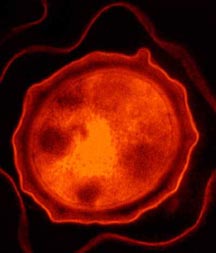Scientists Learn How Anthrax Creates Its Infectious Spores
In the age-old battle between man and microbe, it pays to
know your enemy. This is especially true for Bacillus anthracis,
the bacterium that causes anthrax. Tiny spores of this highly
infectious pathogen can survive drought, bitter cold, and
other harsh conditions for decades, yet still germinate almost
instantly to infect and kill once inside an animal or human
host.
In a collaboration funded by the U.S. Office of Naval Research
and the National Institutes of Health, scientists from three
major research institutions – the University of Michigan,
The Institute for Genomic Research (TIGR), and The Scripps
Research Institute – are working together to identify
the genes and proteins involved in anthrax's deadly metamorphosis.
Their work provides information other researchers can use
to develop new vaccines and treatments targeted at specific
points in the complex process of anthrax growth and spore
formation.
The first results of the collaboration's work will be published
as the cover story in the January 1, 2004 issue of the Journal
of Bacteriology and are currently posted on the journal's
web site. This study is the first analysis of a bacterial
pathogen using the combined investigative tools of genomics
and proteomics. It is also the first study to document, at
a molecular level, all the genes and proteins involved in
B. anthracis spore formation.
"[The study] clearly demonstrates the benefits of combining
genomics and proteomics in a single study," says Hongbin Liu,
the paper's first author and a former Scripps Research postdoctoral
fellow. "The combined approach helped deepen our understanding
of the complexity of spore growth and sporulation."
Major findings of the study include:
• When compared to other bacteria, anthrax spore formation
is an unusually complex and intricate process. ¡ Up to one-third
of all the genes in the Bacillus anthracis genome are
involved in spore production.
• Genes are expressed in five discrete phases over
a five-hour time period.
• Each mature anthrax spore contains about 750 individual
proteins.
The collaboration's scientists identified 2,090 B. anthracis
genes, of nearly 6,000 in the entire genome, which appear
to be involved in spore formation. Gene activity occurred
in five overlapping waves spread across a five-hour time period,
but actual construction of the spore didn't begin until the
fourth wave of gene expression.
Complete data from the collaboration's study of the genome
and proteome of B. anthracis spores has been posted
on the National Center for Biotechnology Information's Gene
Expression Omnibus database at http://www.ncbi.nlm.nih.gov/entrez/query.fcgi?dg=geo.,
where it will be freely available to the scientific community.
While the data will be extremely valuable to biomedical researchers,
it has no value related to the use of anthrax as a biological
weapon.
The article, "Formation and Composition of the Bacillus
anthracis Endospore," was authored by Hongbin Liu, Nicholas
H. Bergman, Brendan Thomason, Shamira Shallom, Alyson Hazen,
Joseph Crossno, David A. Rasko, Jacques Ravel, Timothy D.
Read, Scott N. Peterson, John Yates, III, and Philip C. Hanna.
It appears in the Journal of Bacteriology, Vol.186,
pp. 164-178, Jan. 2004 and is posted online at: http://jb.asm.org/content/vol186/issue1/index.shtml?etoc.

|

This colorized TEM image of an anthrax
spore, magnified 92,000 times, shows layers of the spore's
tough outer coat surrounded by the balloon-like exosporium.
Photo credit: Brendan Thomason and Philip Hanna, University
of Michigan Medical School. Used with permission from the
Journal of Bacteriology.
|

